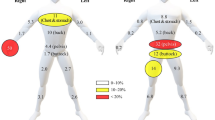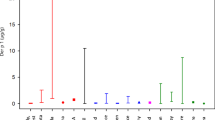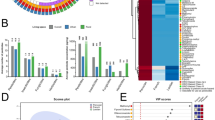Abstract
Pesticides applied indoors may persist longer than they would in outdoor environments, making people more vulnerable to the risk of exposure. Permethrin is a pyrethroid insecticide used in agricultural, residential, and public health sites, and is commonly detected in indoor environments. The objectives of this study were to evaluate the persistence of permethrin indoors and to estimate the levels of possible dermal and non-dietary exposure to this insecticide. Permethrin was applied on aluminum foil and kept in a glass chamber and a test house for 112 days; its concentration was measured at application and after 28, 56, and 112 days. Permethrin persisted for the entire 112 days in concentrations equal to a maximum of 89.6% of the initial concentration. We observed low levels of human dermal and non-dietary exposure to permethrin.
This is a preview of subscription content, access via your institution
Access options
Subscribe to this journal
Receive 6 print issues and online access
$259.00 per year
only $43.17 per issue
Buy this article
- Purchase on Springer Link
- Instant access to full article PDF
Prices may be subject to local taxes which are calculated during checkout
Similar content being viewed by others
References
Feo ML, Eljarrat E, Barcelo D. Determination of pyrethroid insecticides in environmental samples. Trends Anal Chem. 2010;29:692–705.
Kolaczinski JH, Curtis CF. Chronic illness as a result of low-level exposure to synthetic pyrethroid insecticides: a review of the debate. Food Chem Toxicol. 2004;42:697–706.
Krieger RI, Bernard CE, Dinoff TM, Ross JH, Williams RL. Biomonitoring of persons exposed to insecticides used in residences. Ann Occup Hyg. 2001;45:S143–153.
Lewis RG. Residential post-application pesticide exposure monitoring. In: Franklin CA, Worgan JP, (eds.). Occupational and Residential Exposure Assessment for Pesticides. Chichester: John Wiley and Sons Ltd.; 2005. p. 71–128.
Butte W. Sources and impacts of pesticides in indoor environments. In: Hutzinger O, (ed.). The Handbook of Environmental Chemistry. Berlin: Springer-Verlag; 2004. vol. 4, p. 89–116.
Lioy PJ, Freeman NCG, Millette JR. Dust: a metric for use in residential and building exposure assessment and source characterization. Environ Health Perspect. 2002;110:969–83.
USEPA. Reregistration Eligibility Decision (RED) for permethrin, USEPA: Washington, 2009. https://archive.epa.gov/pesticides/reregistration/web/pdf/permethrin-red-revised-may2009.pdf.
Berger-Preiss E, Levsen K, Leng G, Idel H, Sugiri D, Ranft U. Indoor pyrethroid exposure in homes with woolen textile floor coverings. Int J Hyg Environ Health. 2002;205:459–72.
Quandt SA, Arcury TA, Rao P, Snively BM, Camann DE, Doran AM, et al. Agricultural and residential pesticides in wipe samples from farmworker family residences in North Carolina and Virginia. Environ Health Perspect. 2004;112:382–7.
Julien R, Adamkiewicz G, Levy JI, Bennett D, Nishioka M, Spengler JD. Pesticide loadings of select organophosphate and pyrethroid pesticides in urban public housing. J Expo Sci Environ Epidemiol. 2008;18:167–74.
Starr J, Graham S, Stout DM II, Andrews K, Nishioka M. Pyrethroid pesticides and their metabolites in vacuum cleaner dust collected from homes and day-care centers. Environ Res. 2008;108:271–9.
Stout DM II, Bradham KD, Egeghy PP, Jones PA, Croghan CW, Ashley PA, et al. American Healthy Homes Survey: a national study of residential pesticides measured from floor wipes. Environ Sci Technol. 2009;43:4294–300.
Quirós-Alcalá L, Bradman A, Nishioka M, Harnly ME, Hubbard A, Mckone TE, et al. Pesticides in house dust from urban and farmworker households in California: an observational measurement study. Environ Health. 2011;10:19.
Lu C, Adamkiewicz G, Attfield K, Kapp M, Spengler JD, Tao L, et al. Household pesticide contamination from indoor pest control applications in urban low-income public housing dwellings: a community-based participatory research. Environ Sci Technol. 2013;47:2018–25.
Go V, Garey J, Wolff MS, Pogo BG. Estrogenic potential of certain pyrethroid compounds in the MCF-7 human breast carcinoma cell line. Environ Health Perspect. 1999;107:173–7.
Sun H, Xu X-L, Xu L-C, Song L, Hong X, Chen J-F, et al. Antiandrogenic activity of pyrethroid pesticides and their metabolite in reporter gene assay. Chemosphere. 2007;66:474–9.
USEPA. Standard Operating Procedures for Residential Pesticide Exposure Assessment, USEPA: Washington, 2012. https://www.epa.gov/sites/production/files/2015-08/documents/usepa-opp-hed_residential_sops_oct2012.pdf.
Weschler CJ, Nazaroff WW. SVOC exposure indoors: fresh look at dermal pathways. Indoor Air. 2012;22:356–77.
Williams RL, Bernard CE, Krieger RI. Human exposure to indoor residential cyfluthrin residues during a structured activity program. J Expo Anal Environ Epidemiol. 2003;13:112–9.
Keenan JJ, Vega H, Krieger RI. Potential exposure of children and adults to cypermethrin following use of indoor insecticide foggers. J Environ Sci Health B. 2009;44:538–45.
Keenan JJ, Ross JH, Sell V, Vega HM, Krieger RI. Deposition and spatial distribution of insecticides following fogger, perimeter sprays, spot sprays, and crack-and-crevice applications for treatment and control of indoor pests. Regul Toxicol Pharmacol. 2010;58:189–95.
Leng G, Berger-Preiss E, Levsen K, Ranftd U, Sugiri D, Hadnagy W, et al. Pyrethroids used indoor—ambient monitoring of pyrethroids following a pest control operation. Int J Hyg Environ Health. 2005;208:193–9.
Nakagawa LE, Costa AR, Polatto R, do Nascimento CM, Papini S. Pyrethroid concentrations and persistence following indoor application. Environ Toxicol Chem. 2017;36:2895–8.
Berger-Preiss E, Preiss A, Sielaff K, Raabe M, Ilgen B, Levsen K. The behaviour of pyrethroids indoors: a model study. Indoor Air. 1997;7:248–61.
Shin H-M, McKone TE, Tulve NS, Clifton MS, Bennett DH. Indoor residence times of semivolatile organic compounds: model estimation and field evaluation. Environ Sci Technol. 2013;47:859–67.
Zartarian V, Jianping X, Glen G, Smith L, Tulve N, Tornero-Velez R. Quantifying children’s aggregate (dietary and residential) exposure and dose to permethrin: application and evaluation of EPA’s probabilistic SHEDS-Multimedia model. J Expo Sci Environ Epidemiol. 2012;22:267–73.
Bennet DH, Furtaw EJ. Fugacity-based indoor residential pesticide fate model. Environ Sci Technol. 2004;38:2142–52.
Tulve NS, Egeghy PP, Fortmann RC, Jianping X, Evans J, Whitaker DA, et al. Methodologies for estimating cumulative human exposures to current-use pyrethroid pesticides. J Expo Sci Environ Epidemiol. 2011;21:317–27.
Colt JS, Lubin J, Camann D, Davis S, Cerhan J, Severson RK, et al. Comparison of pesticide levels in carpet dust and self-reported pest treatment practices in four US sites. J Expo Sci Environ Epidemiol. 2004;14:74–83.
Morgan MK. Children’s exposures to pyrethroid insecticides at home: a review of data collected in published exposure measurement studies conducted in the United States. Int J Environ Res Public Health. 2012;9:2964–85.
Beamer P, Canales RA, Leckie JO. Developing probability distributions for transfer efficiencies for dermal exposure. J Expo Sci Environ Epidemiol. 2009;19:274–83.
Nakagawa LE, Papini S. Evaluation of dermal transfer of permethrin from different surfaces. Abstracts of World Toxicologic Pathology Congress. Brazil: University of São Paulo; 2018. p. 21–6.
Acknowledgements
We thank the São Paulo Research Foundation (FAPESP) for financial support and for granting a technical trainee scholarship to C. M. Nascimento.
Author information
Authors and Affiliations
Corresponding author
Ethics declarations
Conflict of interest
The authors declare that they have no conflict of interest.
Additional information
Publisher’s note: Springer Nature remains neutral with regard to jurisdictional claims in published maps and institutional affiliations.
Supplementary information
Rights and permissions
About this article
Cite this article
Nakagawa, L.E., do Nascimento, C.M., Costa, A.R. et al. Persistence of indoor permethrin and estimation of dermal and non-dietary exposure. J Expo Sci Environ Epidemiol 30, 547–553 (2020). https://doi.org/10.1038/s41370-019-0132-7
Received:
Revised:
Accepted:
Published:
Issue Date:
DOI: https://doi.org/10.1038/s41370-019-0132-7
Keywords
This article is cited by
-
Pyrethroid exposure among children residing in green versus non-green multi-family, low-income housing
Journal of Exposure Science & Environmental Epidemiology (2021)



